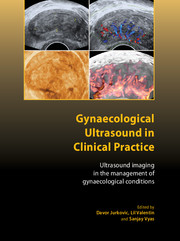 Gynaecological Ultrasound in Clinical Practice
Gynaecological Ultrasound in Clinical Practice Book contents
- Frontmatter
- Contents
- About the authors
- Abbreviations
- Preface
- 1 Ultrasound imaging in gynaecological practice
- 2 Normal pelvic anatomy
- 3 The uterus
- 4 Postmenopausal bleeding: presentation and investigation
- 5 HRT, contraceptives and other drugs affecting the endometrium
- 6 Diagnosis and management of adnexal masses
- 7 Ultrasound assessment of women with pelvic pain
- 8 Ultrasound of non-gynaecological pelvic lesions
- 9 Ultrasound imaging in reproductive medicine
- 10 Ultrasound imaging of the lower urinary tract and uterovaginal prolapse
- 11 Ultrasound and diagnosis of obstetric anal sphincter injuries
- 12 Organisation of the early pregnancy unit
- 13 Sonoembryology: ultrasound examination of early pregnancy
- 14 Diagnosis and management of miscarriage
- 15 Tubal ectopic pregnancy
- 16 Non-tubal ectopic pregnancies
- 17 Ovarian cysts in pregnancy
- Index
13 - Sonoembryology: ultrasound examination of early pregnancy
Published online by Cambridge University Press: 05 February 2014
- Frontmatter
- Contents
- About the authors
- Abbreviations
- Preface
- 1 Ultrasound imaging in gynaecological practice
- 2 Normal pelvic anatomy
- 3 The uterus
- 4 Postmenopausal bleeding: presentation and investigation
- 5 HRT, contraceptives and other drugs affecting the endometrium
- 6 Diagnosis and management of adnexal masses
- 7 Ultrasound assessment of women with pelvic pain
- 8 Ultrasound of non-gynaecological pelvic lesions
- 9 Ultrasound imaging in reproductive medicine
- 10 Ultrasound imaging of the lower urinary tract and uterovaginal prolapse
- 11 Ultrasound and diagnosis of obstetric anal sphincter injuries
- 12 Organisation of the early pregnancy unit
- 13 Sonoembryology: ultrasound examination of early pregnancy
- 14 Diagnosis and management of miscarriage
- 15 Tubal ectopic pregnancy
- 16 Non-tubal ectopic pregnancies
- 17 Ovarian cysts in pregnancy
- Index
Summary
Introduction
The introduction of diagnostic ultrasound into clinical practice 40 years ago provided a new safe and non-invasive method for in vivo studies of early pregnancy development. The initial studies primarily focused on biometrical descriptions of early pregnancy, while later work was more concerned with normal and abnormal morphological features of embryos and early fetuses. Major improvement in the ultrasound assessment of early pregnancy came with the introduction of transvaginal ultrasound at the end of the 1980s. High-frequency transvaginal transducers improved the image quality to such an extent that a detailed description of the embryonic morphology became possible with in-depth anatomical studies of the brain compartments, the spine, the heart, the stomach, the midgut herniation and the limbs.
Ultrasound examination of the embryo and early fetus
There are three main characteristics that mark the early human conceptus: its small size, its rapidly changing anatomical appearance and its uniform development and constant growth (Figure 13.1). The size of the young human conceptus in the first trimester puts high demands on image resolution. It is therefore important to get as close as possible to the target: use the transvaginal approach instead of the transabdominal route and use high-frequency transducers such as 7.5 MHz or more. With the transvaginal approach, acoustic noise (phase front aberrations and reverberations) and attenuation are reduced, thus improving the image resolution.
Standardisation of the orientation of the images is an important process in improving the diagnostic quality.
Keywords
- Type
- Chapter
- Information
- Gynaecological Ultrasound in Clinical PracticeUltrasound Imaging in the Management of Gynaecological Conditions, pp. 143 - 158Publisher: Cambridge University PressPrint publication year: 2009
- 1
- Cited by


